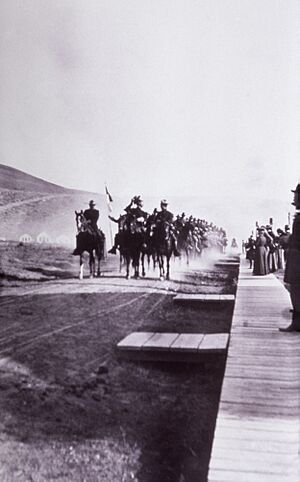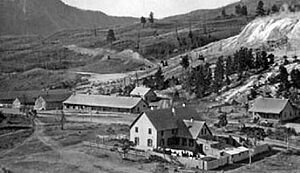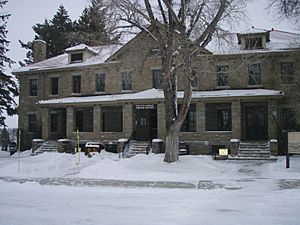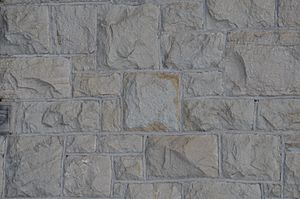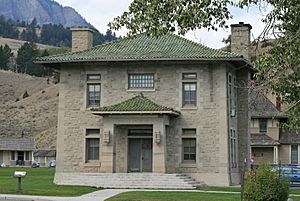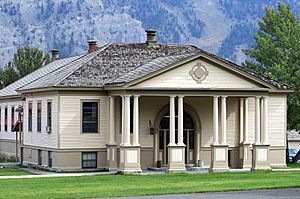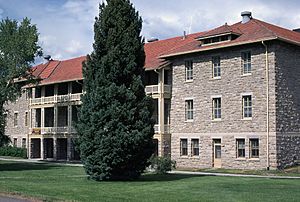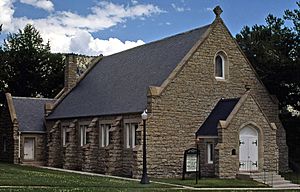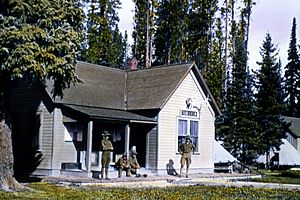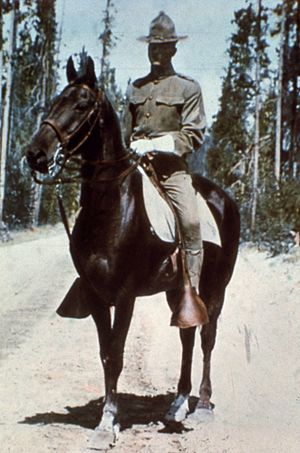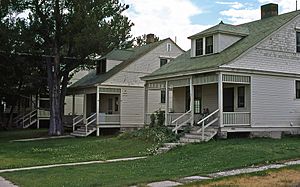Fort Yellowstone facts for kids
|
Fort Yellowstone
|
|
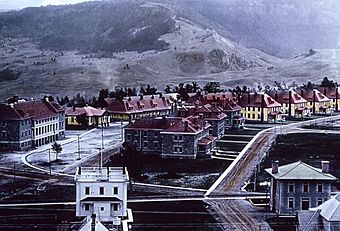
Fort Yellowstone, circa 1910
|
|

Fort Yellowstone map
|
|
| Location | Yellowstone National Park, Park County, Wyoming, United States |
|---|---|
| Nearest city | Gardiner, Montana |
| Built | 1891 |
| Architect | US Army Chief Quartermaster, Dakota; Reed and Stem, Robert Reamer |
| Architectural style | Colonial Revival |
| NRHP reference No. | 03001032 |
Quick facts for kids Significant dates |
|
| Added to NRHP | July 31, 2003 |
| Designated NHL | July 31, 2003 |
Fort Yellowstone was a U.S. Army base built in 1891 at Mammoth Hot Springs inside Yellowstone National Park. Yellowstone became a national park in 1872, but the government agency in charge, the Interior Department, found it hard to manage. So, in August 1886, the job was given to the War Department (the Army).
General Philip Sheridan sent soldiers to Mammoth Hot Springs to build a cavalry post. At first, they called it Camp Sheridan after the general. But in 1891, when they started building a permanent fort, the name changed to Fort Yellowstone. The Army managed the park until 1918. Then, a new agency called the National Park Service took over. Today, the buildings at Fort Yellowstone are used as the main offices for Yellowstone National Park, the Horace Albright Visitor Center, and homes for park staff.
Between 1891 and 1913, about 60 buildings were put up at Fort Yellowstone. Many of them are still standing today. The fort was built in two main stages. From 1891 to 1897, most buildings were made of wood in a "cottage style." Some had Colonial Revival design elements. The second building period started in 1908 and finished in 1913. These structures were mostly made from local sandstone. Many of these later buildings are now used as offices, homes for park employees, museums, and the visitor center. The Army also built small cabins for soldiers on patrol around the park.
Besides the buildings, the Army left behind important rules and ways of doing things. These ideas later helped the National Park Service manage all national parks. The Army commanders started patrols in the backcountry, protected wildlife, and looked after natural features. Their educational programs were also used by the National Park Service. The Army also created a system to enforce laws and developed a ranger force to deal with illegal activities in the parks. Even the campaign hat worn by Park Rangers today is similar to the hats worn by Army soldiers in Yellowstone.
Contents
History of Fort Yellowstone
Yellowstone National Park was created on March 1, 1872. It was the world's first national park, more than 40 years before the National Park Service even existed. From 1872 to 1886, the Interior Department managed the park. But they had very few resources and not much power to protect the park's nature and animals. Things like poaching (illegal hunting), vandalism, and other harmful activities were a big problem.
Over the next ten years, groups like businesses, railroads, and mining companies tried to take over parts of the park for their own profit. The Interior Department didn't have enough money to stop the damage. Sometimes, they even worked with these groups. Senator George Vest worked hard to stop railroads and other businesses from harming the park. He and other members of Congress believed that only the military could truly protect Yellowstone. Because of Senator Vest's efforts, a new law in 1883 allowed the Interior Department to give control of the park to the War Department (the Army). This helped protect Yellowstone from being used for commercial schemes.
In August 1886, Lieutenant General Philip Sheridan sent Company M of the 1st U.S. Cavalry to the park. They set up Camp Sheridan, named after General Sheridan, at Mammoth Hot Springs. Camp Sheridan was a collection of temporary buildings near the Mammoth Hot Springs travertine terraces. None of these original buildings are left today.
In 1891, Congress provided money to build a permanent fort. The Interior Department set aside land just north of Camp Sheridan for these new buildings. On May 11, 1891, Camp Sheridan was renamed Fort Yellowstone. The Army continued to use Fort Yellowstone until October 1918. At that time, they handed over control of the park and the fort to the new National Park Service.
Fort Yellowstone was recognized as a National Historic Landmark on July 31, 2003. The fort and other buildings built by park businesses later on are now part of what is called the Mammoth Hot Springs Historic District.
Buildings and Facilities
Fort Yellowstone was built between 1891 and 1913 on the eastern edge of the Mammoth Hot Springs terraces. It cost a lot of money to build. By 1905, three more groups of cavalry soldiers had joined the original 50 soldiers. Because of this, the fort's buildings were almost always being expanded to meet the needs of park management, soldier training, and the growing number of visitors.
The first group of buildings, constructed between 1891 and 1897, looked like typical Army posts of that time. Like other military bases in the West, the earliest buildings at Fort Yellowstone followed standard Army plans. They had a simple look, with some Colonial Revival style home features, which the Army called "cottage style."
These buildings were one to two-and-a-half stories tall. They were made of wood with stone foundations, evenly spaced windows, and large porches.
A second major building phase began in 1908. This is when the impressive stone buildings you see at Fort Yellowstone today were constructed. These buildings were made from local sandstone. The most famous building from this later period is the Horace Albright Visitor Center. It was originally the bachelor officers' quarters (Building 1). Each historic building at the fort has an official number. Architects Reed and Stem and Robert Reamer, along with the U.S. Army Office of the Chief Quartermaster, helped design many of the buildings. Captain Hiram M. Chittenden of the U.S. Corps of Engineers designed the engineering facilities and landscaping.
Early Construction (1891–1907)
The very first building at Fort Yellowstone was the guardhouse (Building 9). It was located at the southwest corner of the fort. In 1891, visitors would travel on the lower Mammoth road, which is now a residential area. The guardhouse was the first building they saw, and a guard was always on duty to check visitors entering the park. This building is now a private home. The original fort administration building (Building 8) was right next to the guardhouse and is also a private home today.
Of the twelve buildings built in 1891, two important ones are the double officers' quarters (Buildings 6 and 7) that face the old parade ground. Other buildings from 1891 included a barracks for 60 soldiers, a commissary (food) storehouse (Building 10), a quartermaster (supplies) storehouse (Building 11), a granary (Building 12), a bakery (Building 24), a stable (Building 25), and two of the four non-commissioned officers' (NCO) quarters (Buildings 30 and 33). These NCO quarters were known as "soap-suds row" because many of the NCO wives used to be Army laundresses and earned extra money by washing clothes for the soldiers.
More important buildings were added from 1893 to 1899. These included a 10-bed hospital, homes for hospital staff (Building 14), and a large hay shed (Building 20) built in 1894. Only the hospital staff building remains today and is a private home. The most important building built in 1895 was the U.S. Commissioner's office (Building 49). It had a jail and a home for the U.S. Marshal. The first commissioner, Judge John W. Meldrum, worked from this building for the Army and National Park Service until 1935. This was the first stone building in the fort, located to the west of the main area. It was a one-and-a-half-story sandstone house with a special roof style and a porch. The ground floor had the jail, office, and living areas, while bedrooms were upstairs. Today, it's a private home. This building was paid for by the Lacey Act of 1894. This law, sponsored by U.S. Representative John F. Lacey, was created "To protect the birds and animals in Yellowstone National Park, and to punish crimes in said park."
During this time, two more double officers' quarters (Buildings 4 and 5) were added in 1893, completing "officers' row." Two NCO quarters (Buildings 31 and 32) were added to "soap-suds row" in 1897. The unique cavalry barracks (Building 27), which now holds administrative offices, was built in 1899.
Captain Hiram M. Chittenden was the main engineer for the U.S. Army Corps of Engineers in Yellowstone from 1899 to 1906. The Corps was in charge of building roads and other park structures since 1883. In 1901, Captain Chittenden started projects to improve life at the fort. He had a reservoir built in 1901 to provide water for watering plants, drinking, and fighting fires. Engineers also cleared and planted grass in front of officers' row to create a parade ground. They planted grass around other buildings to reduce dust in the summer. In 1902, Fort Yellowstone switched from oil lamps to electric lights after Chittenden built a power plant. The power plant and reservoir are gone, but most of the grassy areas Chittenden planned are still there.
In 1903, Captain Chittenden also oversaw the design and building of the second stone building in Yellowstone: the engineers' headquarters (Building 39). It was often called the "Pagoda" because of its design. This building is in a noticeable but separate spot north of the fort. In 1918, when the National Park Service took over, this building became the first official park headquarters.
Another famous Yellowstone landmark, the Roosevelt Arch, was built in 1903 under Chittenden's supervision. A north entrance station near Gardiner, Montana, was first suggested in 1899. But it wasn't until 1903 that Chittenden and Major John Pitcher (who was acting as park superintendent) got approval for the arch. The groundbreaking for the arch happened during U.S. President Theodore Roosevelt's two-week visit to the park. Roosevelt was the only U.S. President to visit Yellowstone while the Army was in charge. On his last day in the park, April 24, 1903, Roosevelt helped lay the cornerstone, and the arch was finished later that year. In 1904, Major John Pitcher suggested building several new buildings for the growing number of soldiers. The only one approved was the new post exchange (a store for soldiers) south of the cavalry barracks. This impressive Colonial Revival style building was finished in 1905. It replaced a much smaller post exchange built in 1894. Today, it serves as the National Park Service canteen.
Later Construction (1908–1913)
The second major building phase began in 1908. This is when the largest buildings at the fort were constructed. These include the three-story double barracks (Building 36), which now houses the park superintendent's office and is the modern park headquarters. Another large building was the bachelor officers' quarters (Building 1), built just to the west, facing the parade ground. This important building is at the northwest corner of the main fort area and holds the Horace Albright Visitor Center, a museum, a theater, and the Yellowstone Association gift shop.
Officers' row was completed with the building of a double captains' quarters (Building 2) and a field officers' quarters (Building 3) just south of the bachelor officers' quarters. Cavalry stables (Buildings 34 and 38), a double stable guardhouse, and a blacksmith shop (Building 37) were built behind these homes. All these buildings are now used by the National Park Service as offices, maintenance facilities, or homes.
The Army needed a more modern guardhouse because the number of soldiers was growing. The War Department didn't want to pay for a stone guardhouse, so in 1911, it was built from concrete.
The last building constructed at Fort Yellowstone was the chapel, located just south of the original guardhouse. The Army usually didn't build places of worship at forts. However, because park superintendent Pitcher, U.S. Commissioner Meldrum, and Wyoming state senator Francis E. Warren insisted, Congress provided money for the chapel in 1909. The building was finished in January 1913. On September 19, 1914, Katharine Piercy Edmunds and Captain Albert Ady King were the first couple to get married in the new chapel.
Remote Facilities
To give soldiers shelter during overnight patrols, the Army built soldier and snowshoe cabins in remote and popular tourist spots. Most of these cabins are gone now, but the National Park Service still maintains similar, more modern cabins throughout the park.
The first soldier cabins were built in 1886 as part of Camp Sheridan, but they were all later removed. Cabins were also built at places like Lower Geyser Basin, Upper Geyser Basin, Grand Canyon of the Yellowstone, and Riverside. As more outposts were needed, cabins were built at many other locations over the years. While most of these old cabins no longer exist, four remote structures remain. These include the Buffalo Lake snowshoe cabin (Building 234) and the Norris and Bechler River soldier stations (Buildings 111 and 231). The Norris soldier station now houses the Museum of the National Park Ranger. Also, the Bechler River barn (Building 232) is still standing.
The Army's Impact on Yellowstone
The U.S. Army managed Yellowstone so well that by 1891, they were also managing Sequoia, Yosemite, and Kings Canyon National Park in California, and Mackinac National Park in Michigan. The National Park Service later adopted the Army's methods and used them as a guide for managing national parks.
While in Yellowstone, the Army created rules that focused on protecting park resources, keeping visitors safe, and interacting positively but firmly with visitors. Under the Army's care, Yellowstone's hot springs, forests, and wildlife were protected from vandalism, fires, and poaching. These practices were adopted by the National Park Service and are still a key part of how national parks are managed today. The Army's strong actions against poaching led to the Lacey Act of 1894. This law provided legal protection for wildlife and ways to punish those who broke the rules. The fact that most of the Army's ideas were later used by the National Park Service shows how important the Army was in the history of U.S. national parks. Even modern Park Ranger uniforms, especially the iconic campaign hat, are a legacy of the Army's time in Yellowstone.
When Company M, 1st U.S. Cavalry, arrived in Yellowstone, Captain Moses Harris, a Civil War hero, created a set of rules. His staff enforced these rules to protect park resources, and many are still followed today:
- Cutting green trees or removing any minerals or natural wonders is not allowed.
- Hunting or trapping and using firearms in the park is forbidden. Fishing is only allowed with a hook and line, and selling fish caught this way is also not allowed.
- Wagon tires on freight wagons must be at least four inches wide.
- Camping groups should only build fires when absolutely necessary.
- Selling alcohol, except by hotel owners to their guests for their own use, is strictly forbidden.
- People who enter the park for illegal reasons or who break these rules on purpose will be removed from the park.
- No rocks, sticks, or other things should be thrown into any of the springs or geysers.
- All soldiers are ordered to be watchful and careful in enforcing these rules. They should be polite but firm when giving orders.
Even though Harris and his soldiers strictly enforced the rules and arrested many people, there was no legal way to prosecute or punish them. All Harris could do was kick violators out of the park.
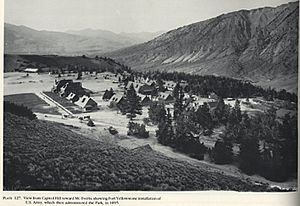
Captain Harris and his successor, Captain Frazier Augustus Boutelle, set up a network of soldier and snowshoe cabins throughout the remote parts of the park. These cabins were placed about 10 miles apart. Soldiers used them year-round to watch for wildfires, vandalism, and poaching. Park Rangers still use remote cabins for patrolling the park today. Captain Young, during his first time as Acting Superintendent in 1897, created patrol cabin rules that Park Rangers still follow. Young required soldiers using a patrol cabin to keep a daily log of activities, including counting animals, visitors, and observing the weather. These logs were used to create a monthly report sent to Fort Yellowstone headquarters. Young gave the following orders to all soldiers using the snowshoe cabins:
- Everyone should use the food in the snowshoe cabins only when necessary. Never waste any of it.
- Always leave the cabins and their contents safe and in good condition.
- The ax and shovel must be left inside. Blankets should be hung up. Cooking tools should be left clean and dry. Food should be in its box, safe from mice.
- Enough dry wood for one night should always be left in the cabin.
Wildlife Protection Policies
Captain Boutelle made many decisions while managing the park, and his ideas about fishing had a big and lasting impact. Boutelle loved to fish and saw the potential for fishing in Yellowstone's waters. In 1889, he suggested that the U.S. Fish Commission consider putting fish into many of Yellowstone's lakes and streams that didn't have any fish.
- "Besides the beautiful Shoshone and other smaller lakes, there are hundreds of miles of fine streams without any fish. I have written to Col. Marshall McDonald, U.S. Fish Commission, about this, and he has shown great interest. I hope through him to see all these waters stocked so that visitors can enjoy great fishing near any hotel or camp."
This suggestion was followed. In 1889, the first fish that were not native to Yellowstone were put into its waters. This continued until 1955 and helped create the famous fishing experience Yellowstone National Park is known for.
In 1902, the number of bison in the park had dropped to about 25 animals. Under Captain Pitcher's leadership, the Army started a program to bring plains bison from private herds in Texas and Montana. Fenced areas were created at Mammoth and in the Lamar Valley. Fields were plowed and planted with oats and timothy to feed the captive bison and the growing elk herds. The bison enclosure in the Lamar Valley became known as the Lamar Buffalo Ranch. When the Army left the park in 1918, the bison population had grown to an estimated 400 animals.
Handing Over to the National Park Service
After serving more than six years as the Acting Superintendent, Major John Pitcher was replaced by Lieutenant General Samuel B.M. Young (retired from the U.S. Army) in June 1907. Young was appointed by the Secretary of the Interior, James Rudolph Garfield, as the full superintendent of the park. Young's lasting contribution was his idea to replace the Army with a group of Civilian Guards. Young knew that the different government agencies (War Department, Corps of Engineers, Interior Department) were not working well together. This was hurting the park's management. Young's idea was not immediately put into action, but it helped set the stage for changes that led to the creation of the National Park Service in 1916 and a Park Ranger force to protect the national parks.
Even though the cavalry had successfully protected the park, by 1914, the average soldier wasn't really suited for the hard, detailed, and diplomatic work needed. World War I also made it more urgent to switch back to civilian management, so the Army could focus on the war. In July 1914, the 1st Cavalry was pulled out of Yellowstone. A mixed group of 200 cavalrymen from different parts of the Army replaced them. Many of these soldiers had served in Yellowstone before.
Throughout 1915–16, the Interior Department was getting ready to manage the growing number of national parks. Finally, Congress created the National Park Service on August 25, 1916. Before the National Park Service was officially established, the War Department agreed to pull troops from Yellowstone by October 1, 1916, which was the end of the park's visitor season. At the same time, the War Department agreed to let some of the current volunteer cavalry soldiers leave the Army on September 29, 1916, so they could work for the National Park Service as Park Rangers.
Unfortunately, Congress didn't provide money for the new National Park Service for 1917, so the ranger force was disbanded in the spring of 1917. Because of pressure from Montana politicians, who worried about losing money from the Army's presence, the Army was called back. 450 soldiers from the 7th Cavalry Regiment were sent back to Fort Yellowstone to protect the park. Control remained with the Interior Department under Acting Superintendent Chester Allinson Lindsley, a long-time civilian employee. Disagreements between the Army, the Corps of Engineers, and the Interior Department continued in 1917–1918 over building plans, ownership of buildings, and use of staff. In 1918, National Park Service Director Stephen Mather convinced Congress and the War Department that civilian control of the National Parks was the right solution. On October 31, 1918, the Army left Yellowstone for the last time.
The Army's Lasting Legacy
John Muir, a famous American naturalist often called the "Father of the National Parks," once wrote: "Blessings on Uncle Sam's Soldiers. They have done the job well, and every pine tree is waving its arms for joy."
While Yellowstone was managed by the Army, the activities, rules, and procedures they developed became examples for other national parks and for the National Park Service after it was formed in 1916. The Army solved many problems and created procedures for various management issues. The military superintendents continued to improve park policies and conservation efforts started by the first civilian managers. They started backcountry patrols, improved access, protected and managed wildlife, protected natural features, enforced laws, and developed a ranger force. The Army set examples for how future park headquarters areas should be designed and how visitor services, like educational programs and tours, should be provided. Their hard work in dealing with poachers led to laws that allowed for the prosecution and punishment of illegal activities. The fact that most of the Army's ideas were later used by the National Park Service is a lasting reminder of the important role the Army played in the history of U.S. national parks. Modern Park Ranger uniforms are also a legacy of the Army's management of the park. Most famously, the campaign hat, a flat-brimmed hat worn by the cavalry in the Army's last years of managing the park, is almost identical to the hats worn by rangers today.
Commanding Officers
The commanding officer of the Fort Yellowstone troops was also called the Acting Superintendent of the park. They reported to both the Army and the Interior Secretary. The following Army officers served in this position at Fort Yellowstone:
- Captain Moses Harris: August 20, 1886 – May 31, 1889
- Captain Frazier Augustus Boutelle: June 1, 1889 – February 15, 1891
- Captain George S. Anderson: February 15, 1891 – June 23, 1897
- Captain Samuel B. M. Young: June 23, 1897 – November 15, 1897
- Captain James B. Erwin: November 15, 1897 – March 15, 1899
- Captain Wilber E. Wilder: March 15, 1899 – June 23, 1899
- Captain Oscar J. Brown: June 23, 1899 – July 24, 1900
- Captain George W. Goode: July 24, 1900 – May 8, 1901
- Captain/Major John Pitcher: May 8, 1901 – June 1, 1907
- Lt. General Samuel B. M. Young (retired): June 1, 1907 – November 28, 1908
- Major H. T. Allen (Commander of troops)
- Major Harry C. Benson: November 28, 1908 – September 30, 1910
- Colonel Lloyd M. Brett: September 30, 1910 – October 15, 1916
Army Units Stationed at Fort Yellowstone
Six different cavalry regiments were stationed at Yellowstone at various times during the Army's management:
- 1st Cavalry Regiment: 1886–1891, 1900–1902, 1911–1914
- 4th Cavalry Regiment: 1898–1899
- 5th Cavalry Regiment: 1909–1910
- 6th Cavalry Regiment: 1892–1897, 1906–1907
- 8th Cavalry Regiment: 1908
- Yellowstone Park Detachment: 1915–1916
- 7th Cavalry Regiment: 1917–1918
Images for kids


